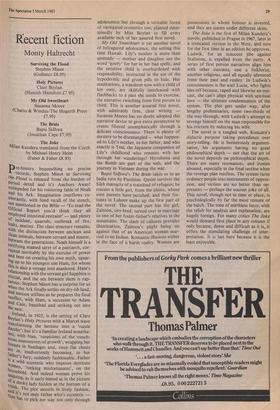Recent fiction
Monty Haltrecht
Surviving the Flood Stephen Minot (Gollancz £8.95) Holy Pictures Clare Boylan
(Hamish Hamilton £7.95)
My Old Sweetheart Susanna Moore (Chatto & Windus/The Hogarth Press £7.95) The Bride Bapsi Sidhwa
(Jonathan Cape £7.95)
The Joke Milan Kundera translated from the Czech by Michael Henry Heim (Faber & Faber £8.95) pre-history bequeathing no precise records, Stephen Minot in Surviving 'le Flood is released from' the burden of Period detail and it's Anchors Away! unimpeded for his roistering fable of Noah and his Ark. Imagination overflows ex- uberantly, with fond recall of the stench, not mentioned in the Bible — 'To read the Official Report you'd think they all employed intestinal restraint' — and plenty of incident, quarrels, outbreak of fire, leaks, mutiny. The class structure remains, With the distinction between unclean and dean animals, between servant and master, between the generations. Noah himself is a terrifying seamed satyr of a patriarch, cor- ruPted inevitably by the exercise of power and bent on creating his own myth, squar- ing up to his youngest son Ham, for whom this is also a voyage into manhood. Ham's relationship with the servant girl Sapphira is crucial, and the sex between them is rap- turous. Stephen Minot has a surprise for us When the Ark finally settles on dry-ish land, and tension stiffens as he prepares the final conflict, with Ham, a successor to Adam and Cain, banished and striking out into the new.
Ireland, in 1925, is the setting of Clare BoYlan's Holy Pictures with a Marcel wave transforming the heroine into a `razzle 5azzler'; but it's a familiar Ireland nonethe- less, with Nan, 'suspicious of the treach- e. rous manoeuvres of growth', wrapping her breasts in bandages and, since flat chests arein, inadvertently becoming, to her .ather's fury, suddenly fashionable. .Father Is a wild eccentric who imposes destitute 11!°Inen, 'reeking misfortunates', on the household. And indeed women prove his utticbc'ing, as is early hinted at in the picture ' a dusky lady hidden at the bottom of a runic. The plot uncoils in lively fashion, not only father who's eccentric — an has to pick her way not only through
adolescence but through a veritable forest of variegated eccentrics too, planted deter- minedly by Miss Boylan to fill every available inch of her assured first novel.
My Old Sweetheart is yet another novel of beleagured adolescence, the setting this time Hawaii. Lily's mother is more than unsteady — mother and daughter use the word 'goofy' for her in her bad spells, and the sensitive child is overburdened with responsibility, instructed in the use of the hypodermic and given pills to hide. Her meditations, a wanderer now with a child of her own, are skilfully interleaved with flashbacks to a past she needs to exorcise, the narrative switching from first person to third. This is another assured first novel, with admirably firm, clear writing — Susanna Moore has no doubt adopted this narrative device to give extra perspective to events filtered unemphatically through a delicate consciousness. There is plenty of mystery to be disentangled — what happen- ed to Lily's mother, to her father, and who exactly is Tosi, the Japanese companion of Lily's childhood who remains with her through her wanderings? Hiroshima and the Bomb are part of the web, and the journey in Vietnam during the war.
Bapsi Sidhwa's The Bride takes us to an India torn by Partition. Qasim survives the Sikh massacre of a trainload of refugees; he rescues a little girl, from the plains, whose own parents have perished, and their for- tunes in Lahore make up the first part of the novel. The second part has the girl, Zaitoon, city-bred, turned over in marriage to one of her foster-father's relatives in the mountains. The clash of cultures provides illumination, Zaitoon's plight being set against that of an American woman mar- ried to an Indian. Romantic illusions wither in the face of is harsh reality. Women are
possessions in whom honour is invested, and they are sisters under different skins.
The Joke is the first of Milan Kundera's novels, published in Prague in 1967, later in a truncated version in the West, and now for the first time in an edition he approves. Ludwik, for an innocent jibe against Stalinism, is expelled from the party. A series of first person narratives align him with other outcasts, one a folklorist, another religious, and all equally alienated from their past and reality. In Ludwik's consciousness is the waif Lucie, who fights him off because, raped and likewise an out- cast, she can't align physical with spiritual love — the ultimate condemnation of the system. The plot gets under way, after lengthy preliminaries, some two-thirds of the way through, with Ludwik's attempt to revenge himself on the man responsible for his eviction by seducing his wife.
The novel is a tangled web, KunGera's didactic purpose taking precedence over story-telling. He is boisterously argumen- tative, his arguments having no great philosophical depth — not that the art of the novel depends on philosophical depth. There are many resonances, and ironies abound, especially in the final section when the revenge plan misfires. The system turns ordinary people into instruments of oppres- sion, and victims are no better than op- pressors — perhaps the sourest joke of all. This novel, though not in time or place, is psychologically by far the most remote of the batch. The tone of mirthless farce, with the relish for analysis and explanation, are hugely foreign. For many critics The Joke would demand first place in any column if only because, dense and difficult as it is, it offers the stimulating challenge of inter- pretation. It is last here because it is the least enjoyable.














































 Previous page
Previous page